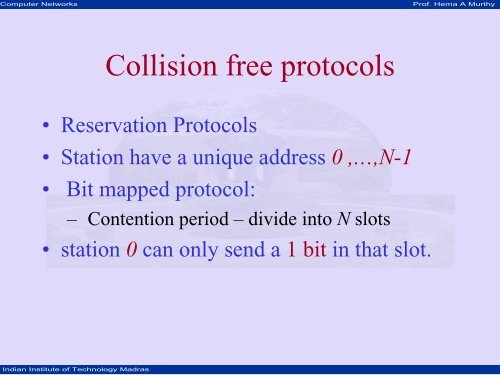Collision free protocols - nptel - Indian Institute of Technology Madras
Collision free protocols - nptel - Indian Institute of Technology Madras
Collision free protocols - nptel - Indian Institute of Technology Madras
Create successful ePaper yourself
Turn your PDF publications into a flip-book with our unique Google optimized e-Paper software.
Computer Networks Pr<strong>of</strong>. Hema A Murthy<br />
<strong>Indian</strong> <strong>Institute</strong> <strong>of</strong> <strong>Technology</strong> <strong>Madras</strong><br />
<strong>Collision</strong> <strong>free</strong> <strong>protocols</strong><br />
• Reservation Protocols<br />
• Station have a unique address 0 ,…,N-1<br />
• Bit mapped protocol:<br />
– Contention period – divide into N slots<br />
• station 0 can only send a 1 bit in that slot.
Computer Networks Pr<strong>of</strong>. Hema A Murthy<br />
<strong>Indian</strong> <strong>Institute</strong> <strong>of</strong> <strong>Technology</strong> <strong>Madras</strong><br />
<strong>Collision</strong> <strong>free</strong> <strong>protocols</strong><br />
• Station j announces that it has a frame to<br />
transmit by inserting a bit in slot j.<br />
• After all N slots have passed by –<br />
– every station knows numerical order<br />
– Now transmit in Numerical order<br />
• no collision at all!
Computer Networks Pr<strong>of</strong>. Hema A Murthy<br />
<strong>Indian</strong> <strong>Institute</strong> <strong>of</strong> <strong>Technology</strong> <strong>Madras</strong><br />
<strong>Collision</strong> <strong>free</strong> <strong>protocols</strong><br />
• After last ready frame transmitted –<br />
– an event generated<br />
• New N bit contention period<br />
• If a station misses<br />
– wait for next contention period
Computer Networks Pr<strong>of</strong>. Hema A Murthy<br />
<strong>Indian</strong> <strong>Institute</strong> <strong>of</strong> <strong>Technology</strong> <strong>Madras</strong><br />
<strong>Collision</strong> <strong>free</strong> <strong>protocols</strong><br />
• After all stations have transmitted<br />
probability <strong>of</strong> having a frame to transmit<br />
middle <strong>of</strong> slot<br />
– wait 1 ½ contention period before transmitting<br />
• Always 1 bit/station/frame transmitted is the<br />
overhead
Computer Networks Pr<strong>of</strong>. Hema A Murthy<br />
<strong>Indian</strong> <strong>Institute</strong> <strong>of</strong> <strong>Technology</strong> <strong>Madras</strong><br />
Efficiency<br />
0 1 2 3 4 5 6 7<br />
1 1 1<br />
High<br />
Low<br />
d<br />
−<br />
load<br />
load<br />
frame<br />
U=<br />
U=<br />
size<br />
1-<br />
contention<br />
d<br />
1 3 7<br />
Nd<br />
d<br />
d<br />
+ 1<br />
+ 1
Computer Networks Pr<strong>of</strong>. Hema A Murthy<br />
<strong>Indian</strong> <strong>Institute</strong> <strong>of</strong> <strong>Technology</strong> <strong>Madras</strong><br />
Contention Free Protocols<br />
• Binary Countdown:<br />
• Better than bit mapped <strong>protocols</strong><br />
• Use binary station addresses<br />
• Each station broadcasts address<br />
– Example: 0010 0100 1001 1100
Computer Networks Pr<strong>of</strong>. Hema A Murthy<br />
<strong>Indian</strong> <strong>Institute</strong> <strong>of</strong> <strong>Technology</strong> <strong>Madras</strong><br />
Contention Free Protocols<br />
• All addresses same length<br />
• Bits in each position from different stations<br />
are ORed<br />
• <strong>Collision</strong> avoidance<br />
– arbitration rule<br />
– if high order bit position <strong>of</strong> station address<br />
overwritten by 1 give up!
Computer Networks Pr<strong>of</strong>. Hema A Murthy<br />
0010<br />
0100<br />
1001<br />
1100<br />
1111<br />
<strong>Indian</strong> <strong>Institute</strong> <strong>of</strong> <strong>Technology</strong> <strong>Madras</strong><br />
Binary CountDown<br />
Compare give up<br />
give up<br />
1100 – gets access!<br />
Next new cycle <strong>of</strong> contention start<br />
Compare next bit<br />
Compare next bit<br />
1001 gives<br />
up
Computer Networks Pr<strong>of</strong>. Hema A Murthy<br />
Binary CountDown:Analysis<br />
<strong>Indian</strong> <strong>Institute</strong> <strong>of</strong> <strong>Technology</strong> <strong>Madras</strong><br />
U<br />
=<br />
d<br />
d<br />
+ ln2<br />
If the higher order bits <strong>of</strong> a station j address are 1,<br />
station j transmits continuously<br />
N
Computer Networks Pr<strong>of</strong>. Hema A Murthy<br />
Limited Contention Protocols<br />
• combine the properties <strong>of</strong> contention and<br />
collision <strong>free</strong> <strong>protocols</strong><br />
• contention at low load to provide low delay<br />
• reservation at high load<br />
<strong>Indian</strong> <strong>Institute</strong> <strong>of</strong> <strong>Technology</strong> <strong>Madras</strong>
Computer Networks Pr<strong>of</strong>. Hema A Murthy<br />
Adaptive Tree Walk Protocol<br />
• Adaptive TreeWalk Algorithm<br />
– low load<br />
<strong>Indian</strong> <strong>Institute</strong> <strong>of</strong> <strong>Technology</strong> <strong>Madras</strong><br />
• every body contends<br />
– collision –<br />
• reduces number <strong>of</strong> stations
Computer Networks Pr<strong>of</strong>. Hema A Murthy<br />
Adaptive Tree Walk Algorithm<br />
4<br />
<strong>Indian</strong> <strong>Institute</strong> <strong>of</strong> <strong>Technology</strong> <strong>Madras</strong><br />
1<br />
2 3<br />
5<br />
a b c de f g h<br />
First contention all stations permitted to contend<br />
6<br />
- if collision then next slot only nodes under 2 can contend<br />
-if success next slot – Nodes under 3<br />
-if collision then nodes under Node 4<br />
-if success next slots Nodes under 5<br />
7
Computer Networks Pr<strong>of</strong>. Hema A Murthy<br />
Adaptive Tree Walk Algorithm<br />
• Depth first tree walk algorithm<br />
• Heavy load do not start searching at top <strong>of</strong><br />
tree<br />
– what level to start the search?<br />
– depends on number <strong>of</strong> ready stations<br />
<strong>Indian</strong> <strong>Institute</strong> <strong>of</strong> <strong>Technology</strong> <strong>Madras</strong>
Computer Networks Pr<strong>of</strong>. Hema A Murthy<br />
Adaptive Tree Walk Algorithm<br />
• Each node at level i has N. 2 –i station under<br />
it.<br />
•qready stations – uniformly distributed at<br />
level i 2 -i q<br />
• level at which search begins<br />
– 2 -i q =1<br />
– i = log 2 q<br />
<strong>Indian</strong> <strong>Institute</strong> <strong>of</strong> <strong>Technology</strong> <strong>Madras</strong>
















